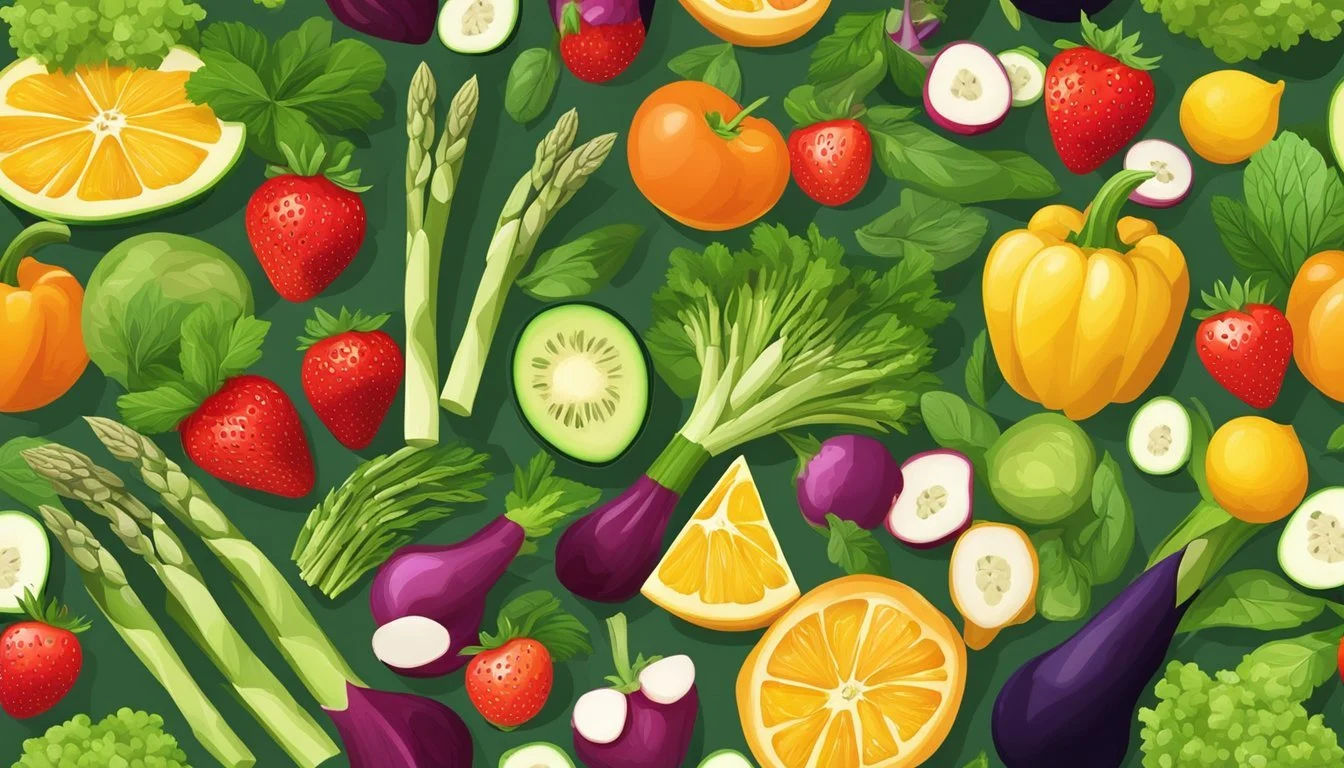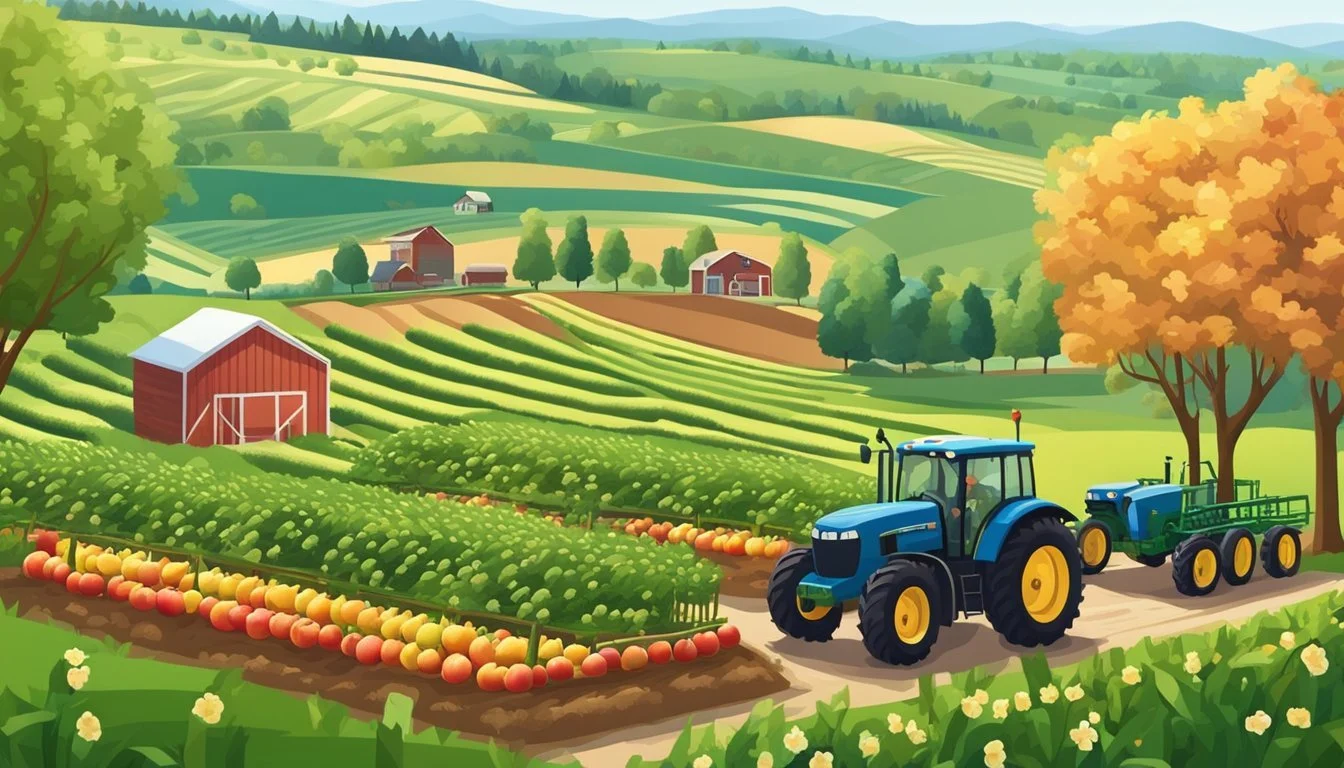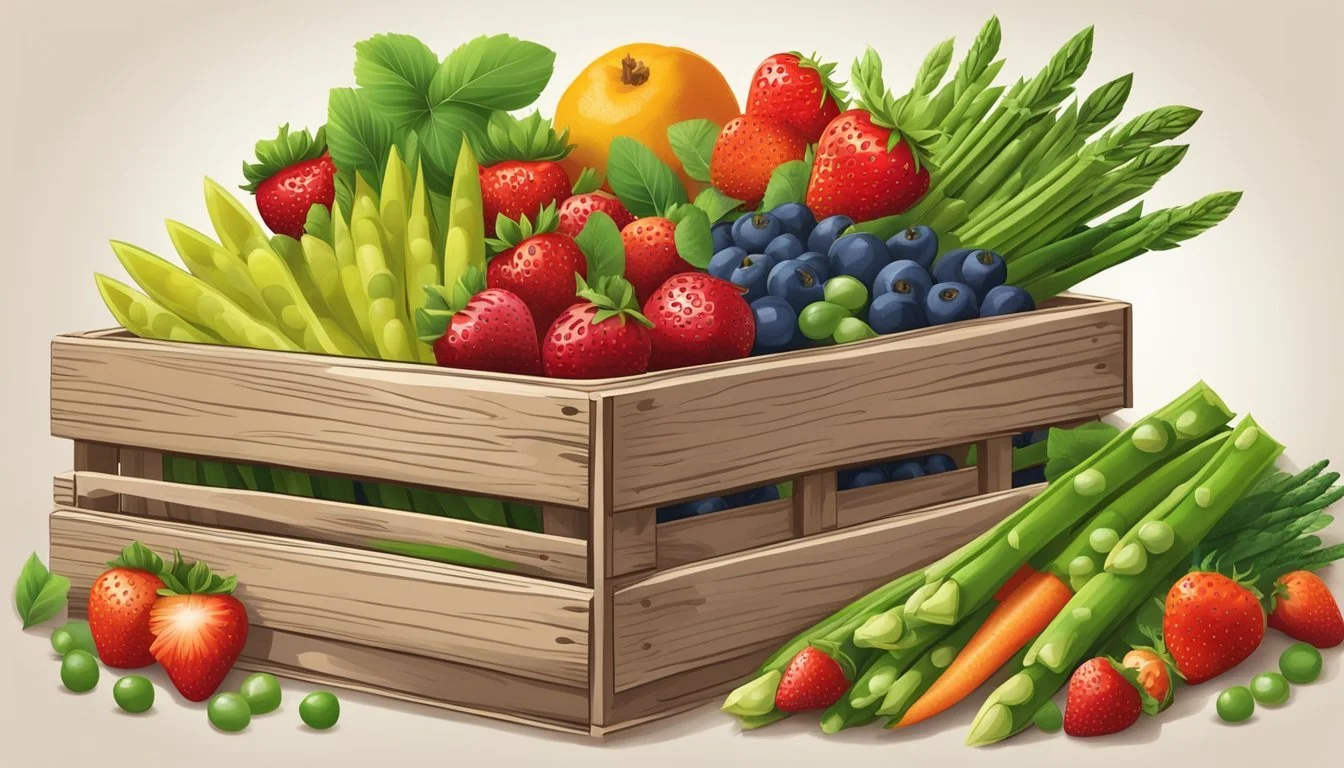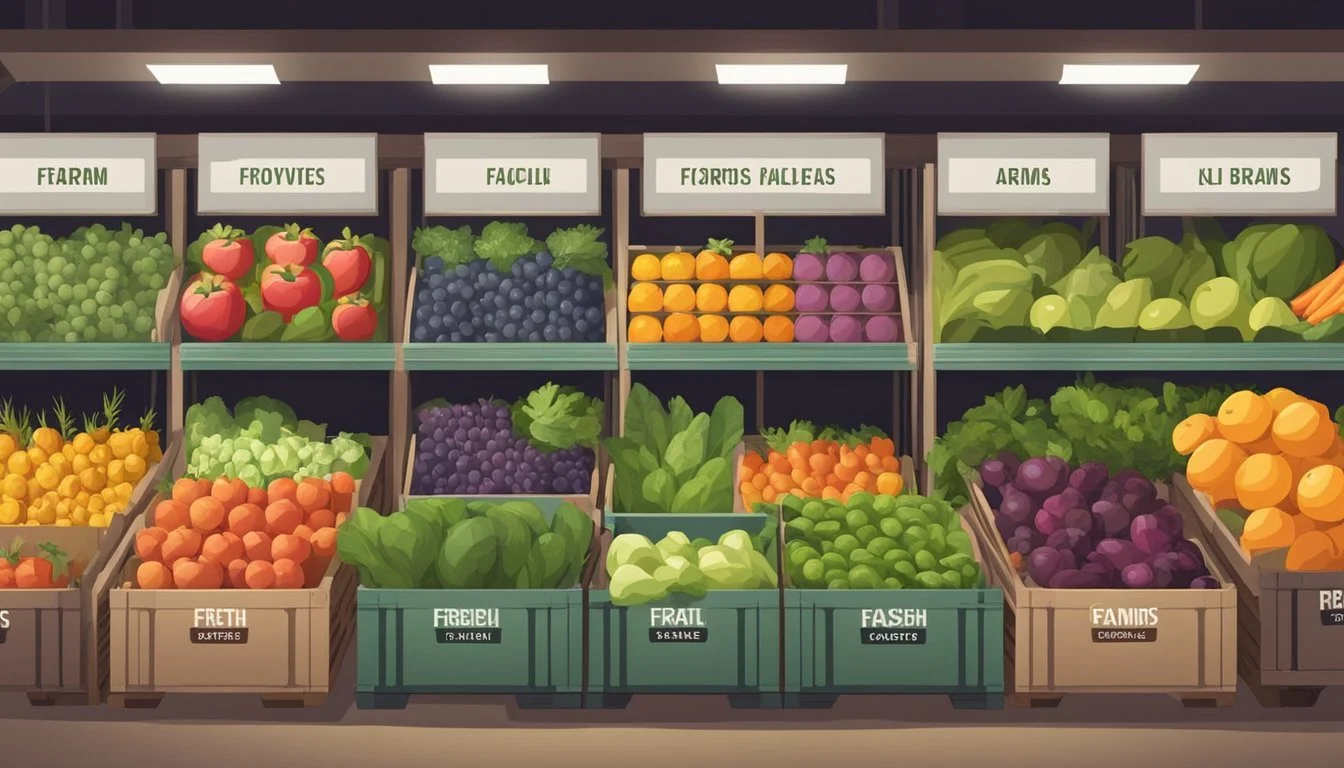Washington Seasonal Fruit & Vegetables in May
Your Fresh Guide
This Article is Part of our Washington Seasonal Fruit & Veg Calendar
May in Washington marks a vibrant transition in the agricultural calendar, as the state's farmers and growers prepare for a bounty of seasonal produce. In this lush Pacific Northwest climate, the late spring weather nurtures a variety of fruits and vegetables, bringing freshness and flavor to local markets. During this period, consumers begin to experience the shift from the hearty root vegetables of winter to the lighter, crisper options characteristic of spring.
Fruit offerings begin to diversify as well. While the region's apple orchards are between harvests, other fruits start to make their seasonal debut. Leafy vegetables thrive in the cool, yet increasingly sunny days. Farmers' markets and grocery stores showcase an array of produce that not only tastes better when harvested in season but also often comes with the added benefit of supporting local agriculture.
For those seeking to incorporate seasonal ingredients into their culinary repertoire, May presents the perfect opportunity to explore a taste of Washington's local agriculture. The state's rich soils and favorable spring conditions yield a selection of produce that is as nutritious as it is flavorful, ready for residents and chefs alike to enjoy.
Washington Seasonal Overview
May in Washington marks a vibrant transition as winter loosens its grip, giving way to the freshness of spring. The cool, wet winter months gradually yield to milder temperatures, infusing life into a wide array of fruits and vegetables. This is a time when local farmers' markets start to showcase a burst of new produce, signaling the start of the growing season.
Spring's arrival in Washington sees the emergence of delicate greens and the first vegetable harvests:
Arugula: This peppery green thrives in the cooler temperatures of late spring.
Asparagus (What wine goes well with asparagus?): A springtime favorite, asparagus spears are in their prime during May.
Beets (how long do beets last?): Hardy and versatile, the growing season for beets stretches into spring.
Farmers begin planting summer crops, anticipating warmer weather. Meanwhile, the tail end of Washington’s weather in May still hints at the crispness of winter, ensuring that the produce retains its fresh, intense flavors. As such, Washingtonians can enjoy a blend of produce available from both the spring and winter seasons.
The fruits in season are sparse as many are yet to reach their peak summer harvest:
Strawberries: These begin to make an appearance, offering a sweet preview of the abundant summer to come.
In essence, May is a month of renewal and preparation in Washington's agricultural calendar. It graciously overlaps the best of spring's bounty with lingering cool-weather favorites, ensuring a variety of fresh produce is available before the heat of summer sets in.
Fruits in Season
In Washington, May heralds the arrival of berry season, with a sweet and juicy variety making their local markets debut. These fruits are known for their vibrant colors and fresh flavors, marking the transition from spring into the heart of summer.
Berries
Strawberries: Typically one of the first berries to ripen, strawberries in May are especially sweet.
Raspberries: While they may start a bit later, raspberries usually begin to appear by the end of May.
Stone Fruits
At this time, stone fruits are not yet in season, with favorites like cherries (how long do cherries last?)and apricots typically ripening in June.
Other Fruits
Rhubarb: Although not a berry, rhubarb is often paired with strawberries and has a tartness that complements the sweetness of early summer fruits. It is available throughout May.
Vegetables in Season
In Washington during the month of May, residents can enjoy a variety of fresh and vibrant vegetables, with an abundance of leafy greens, root vegetables, and a selection of other nutrient-dense veggies reaching their peak seasonality. These offerings are not only fresh and flavorful but also support local agriculture.
Leafy Greens
May marks the prime availability for a diverse range of leafy greens in Washington. Individuals can find lettuce, spinach (What wine goes well with spinach?), kale, and collard greens (how long do collard greens last?)at local farmers' markets or grocers. Arugula and chard are also in season, adding peppery and earthy flavors (What wine goes well with earthy flavors?) to spring dishes. Green garlic, an early harvest variant of mature garlic, offers a subtle and slightly green taste ideal for salad dressings and marinades.
Lettuce
Spinach
Kale
Collard Greens
Arugula
Chard
Green Garlic
Root Vegetables
Root vegetables like radishes, turnips, beets, and carrots are also flourishing in May. These vegetables can be enjoyed raw, providing a crisp texture and a burst of flavor to salads, or they can be cooked to bring out their innate sweetness.
Radishes
Turnips
Beets
Carrots
Other Vegetables
Beyond the leafy greens and root vegetables, a variety of other vegetables are coming into season. Artichokes (What wine goes well with artichokes?) and asparagus can be found at their freshest, perfect for steaming or grilling. Furthermore, garden peas, fava beans, (how long do fava beans last?) and green beans make their seasonal debut, offering versatility in culinary applications from soups to side dishes. Onions and scallions are also widely available, providing foundational flavors to an array of recipes.
Artichokes
Asparagus
Peas
Fava Beans
Green Beans
Onions
Scallions
Preparing and Cooking
In May, chefs and home cooks alike revel in the abundance of fresh produce from Washington. Utilizing the season's best calls for diverse cooking techniques to enhance the natural flavors of fruits and vegetables.
Salads and Raw Dishes
Lettuce and Spinach: Tender greens like lettuce and spinach are at their peak, offering crispness to fresh salads. Wash and dry these leaves gently; it enhances their texture and readies them for dressing.
Peas and Radishes: They lend a sweet and mildly piquant flavor to raw dishes. Peas can be shelled for a burst of sweetness, while radishes add a crunchy, zesty note when thinly sliced.
Asparagus: Although excellent when cooked, asparagus can also be shaved thinly and added raw to salads for a nutty, crunchy element.
Roasted and Grilled
Asparagus: Grilling or roasting asparagus brings out a caramelized, earthy flavor that makes it a versatile side dish.
Preparation: Toss with olive oil, salt, and pepper; grill or roast at 400°F (205°C) for 10-15 minutes.
Green Onions: These become mellow and sweet once charred.
Preparation: A quick stint on the grill or roast until softened adds a depth of flavor to any dish.
Radishes: Roasting radishes diminishes their peppery bite and enhances their natural sweetness.
Preparation: Halve and toss with oil and spices, roast until tender.
Desserts and Jams
Rhubarb: Often used in desserts, rhubarb's tartness pairs well with sweeter fruits.
Preparation: Can be stewed or roasted with a touch of sugar to soften its tang for pies and crumbles.
Berries and Cherries: Washington's berries and cherries are fit for jams and desserts.
Jams: Simmer with sugar and lemon to thicken into spreads.
Desserts: Incorporate into pastries or serve alongside whipped cream or ice cream for a fresh burst of flavor.
Farming and Harvesting Methods
In Washington, May heralds a dynamic period on farms as diverse crops approach their harvest windows. Farmers employ a variety of techniques tailored to each crop's requirements, ensuring quality and sustainability.
Crop Rotation: Practiced by many, this method keeps the soil healthy and prevents pest build-up. Rotating crops like legumes, which fix nitrogen, with cash crops, farmers maintain soil fertility and reduce chemical inputs.
Irrigation: As May's weather can vary, efficient water management is crucial. Systems such as drip irrigation minimize water wastage, essential for crops like berries that begin to ripen in June and July.
Integrated Pest Management (IPM): To protect the May harvest, farmers combine biological, cultural, and chemical controls. This approach targets pests without harming the ecosystem, vital for crops like strawberries that become ripe in late spring.
Manual Labor: Labour is intense around the peak seasons. Farmers directly oversee the harvesting of delicate fruits and vegetables to ensure the utmost care.
Month Farming Activity May Soil preparation, planting June Early harvesting, continuous planting July Peak harvesting
Farmers navigate the seasonal calendar, leveraging these methods to cope with the unpredictability of nature. Efficiency, sustainability, and a deep understanding of crop cycles characterize Washington's farming practices.
Health Benefits
Eating seasonal fruits and vegetables from Washington during May provides numerous health benefits. Fresh produce reaped at peak seasonality often contains higher levels of nutritional value compared to those harvested off-season due to less transport and storage time.
Nutritional Value:
Fruits and vegetables picked in May are at their peak in
Buying Local
In Washington, May marks a season rich with an assortment of fresh produce available directly from local farms and farmers markets. Sourcing fruits and vegetables from these outlets supports the regional economy and bolsters community ties. May's bounty includes morels, asparagus, and a variety of greens that can typically be found at community gathering spots such as neighborhood farmers markets.
Farmers Markets: These are ideal destinations for consumers seeking local produce. They not only provide access to fresh, seasonal items but also offer the opportunity to connect directly with growers. By prioritizing these markets, shoppers contribute to sustainability efforts and reduce the carbon footprint associated with long-distance food transportation.
Local Stands and Co-ops: Many regions within Washington State host roadside stands or cooperative grocery stores. These are excellent sources for seasonal produce and often include:
Fiddlehead ferns: Available in May, foraged locally.
Rhubarb: A tart staple of the area, often used in pies.
Greens: Various types such as arugula and spinach, picked at their peak.
Each purchase at these local establishments not only enhances sustainability but also ensures that the community’s agricultural heritage remains vibrant and productive. Consumers benefit from the freshest produce, knowing it’s delivered from farm to table with minimal delay, while contributing to a stronger, more resilient local food system.
Preservation and Storage
When preserving Washington's seasonal fruits and vegetables in May, consumers and retailers must consider the best methods for extending freshness and flavor. For canning, fruits like strawberries and rhubarb can be transformed into jams or compotes. Vegetables such as asparagus are ideal for pickling—a popular canning choice.
Freezing provides an alternative preservation method, especially for berries and peas. They should be washed, blotted dry, and spread on a tray to freeze individually before being transferred to airtight containers or bags. This prevents clumping and preserves their individual integrity.
Drying is suitable for herbs like parsley and chives (how long do chives last?), which are abundant in May. Herbs can be air-dried or dehydrated in low-temperature ovens to extend their shelf life. Fruits can also be dried but may require pre-treatment to prevent browning.
General storage requires understanding the individual needs of each produce type. Most fruits fare well in refrigeration, while root vegetables like radishes should be stored in cool, dark places. Leafy greens should be kept in moisture-proof bags with paper towels to absorb excess moisture.
By utilizing these methods, consumers can enjoy Washington's bountiful May harvest throughout the year:
Canning: Jams, compotes, pickles
Freezing: Berries, peas, pre-blanch vegetables
Drying: Herbs, fruit slices
Storage: Cool, dry areas for root vegetables; refrigeration for most fruits
Each technique ensures the seasonal produce maintains its taste and nutritional value for future use.










